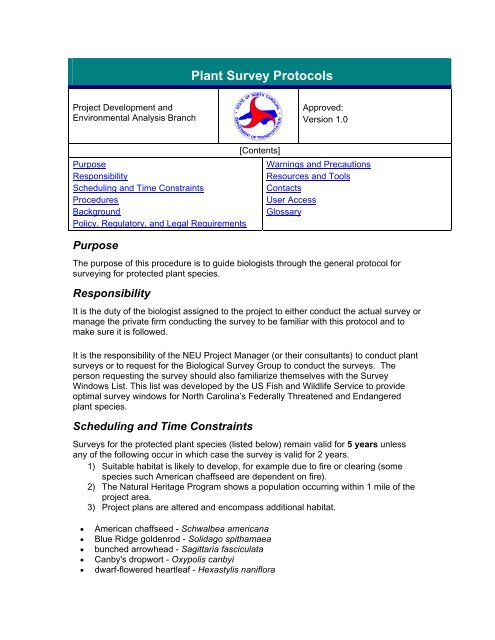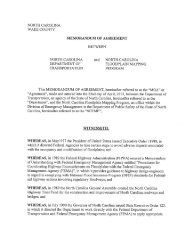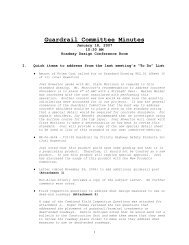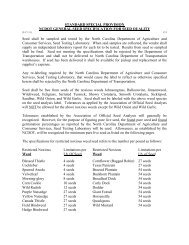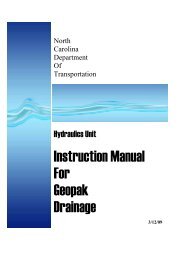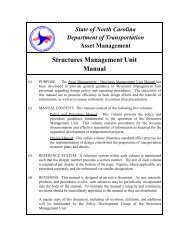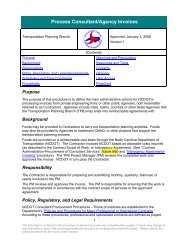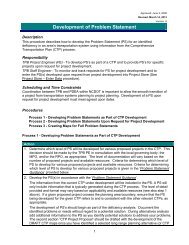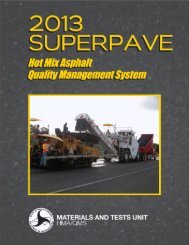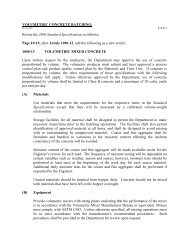Plant Survey Protocol.pdf - Connect NCDOT
Plant Survey Protocol.pdf - Connect NCDOT
Plant Survey Protocol.pdf - Connect NCDOT
Create successful ePaper yourself
Turn your PDF publications into a flip-book with our unique Google optimized e-Paper software.
<strong>Plant</strong> <strong>Survey</strong> <strong>Protocol</strong>s<br />
Project Development and<br />
Environmental Analysis Branch<br />
Approved:<br />
Version 1.0<br />
Purpose<br />
Responsibility<br />
Scheduling and Time Constraints<br />
Procedures<br />
Background<br />
Policy, Regulatory, and Legal Requirements<br />
Purpose<br />
[Contents]<br />
Warnings and Precautions<br />
Resources and Tools<br />
Contacts<br />
User Access<br />
Glossary<br />
The purpose of this procedure is to guide biologists through the general protocol for<br />
surveying for protected plant species.<br />
Responsibility<br />
It is the duty of the biologist assigned to the project to either conduct the actual survey or<br />
manage the private firm conducting the survey to be familiar with this protocol and to<br />
make sure it is followed.<br />
It is the responsibility of the NEU Project Manager (or their consultants) to conduct plant<br />
surveys or to request for the Biological <strong>Survey</strong> Group to conduct the surveys. The<br />
person requesting the survey should also familiarize themselves with the <strong>Survey</strong><br />
Windows List. This list was developed by the US Fish and Wildlife Service to provide<br />
optimal survey windows for North Carolina’s Federally Threatened and Endangered<br />
plant species.<br />
Scheduling and Time Constraints<br />
<strong>Survey</strong>s for the protected plant species (listed below) remain valid for 5 years unless<br />
any of the following occur in which case the survey is valid for 2 years.<br />
1) Suitable habitat is likely to develop, for example due to fire or clearing (some<br />
species such American chaffseed are dependent on fire).<br />
2) The Natural Heritage Program shows a population occurring within 1 mile of the<br />
project area.<br />
3) Project plans are altered and encompass additional habitat.<br />
• American chaffseed - Schwalbea americana<br />
• Blue Ridge goldenrod - Solidago spithamaea<br />
• bunched arrowhead - Sagittaria fasciculata<br />
• Canby's dropwort - Oxypolis canbyi<br />
• dwarf-flowered heartleaf - Hexastylis naniflora
• green pitcher plant - Sarracenia oreophila<br />
• Heller's blazing star - Liatris helleri<br />
• mountain golden heather - Hudsonia montana<br />
• mountain sweet pitcher plant - Sarracenia rubra ssp. jonesii<br />
• pondberry -Lindera melissifolia<br />
• Roan Mountain bluet - Hedyotis [=Houstonia] purpurea var. montana<br />
• rock gnome lichen - Gymnoderma lineare<br />
• spreading avens - Geum radiatum<br />
• swamp pink - Helonias bullata<br />
• white irisette - Sisyrinchium dichotomum<br />
<strong>Survey</strong>s for the following plants are valid for approximately 2 years. These plants may<br />
be more likely to move (for example, due to ease of seed spread/or scour causing<br />
fragmentation or opportunity for seed dispersal during beach renourishment, or the<br />
plant (orchids) may not emerge above-ground every year necessitating the need for<br />
more frequent surveys)<br />
• Cooley's meadowrue - Thalictrum cooleyi<br />
• golden sedge - Carex lutea<br />
• Harperella - Ptilimnium nodosum<br />
• Michaux's sumac - Rhus michauxii<br />
• rough-leaf loosestrife - Lysimachia asperulifolia<br />
• Schweinitz's sunflower - Helianthus schweinitzii<br />
• seabeach amaranth - Amaranthus pumilus<br />
• sensitive joint-vetch -Aeschynomene virginica<br />
• small-anthered bittercress - Cardamine micranthera<br />
• small whorled pogonia - Isotria medeoloides<br />
• smooth coneflower - Echinacea laevigata<br />
• Virginia spiraea - Spiraea virginiana<br />
Procedures<br />
The biologist conducting the survey will follow the steps below.<br />
Step 1. Review the current Threatened and Endangered Species List for the county<br />
the project is located.<br />
Step 2. Reference the <strong>Survey</strong> Windows List to identify the actual times to survey for<br />
the protected plant species.<br />
Step 3. Prior to conducting the survey, prepare by visiting a known population as<br />
close to the proposed project site as possible to review the plant’s local<br />
appearance, habitat, and flowering status. Populations can be located by:<br />
• Consulting the N.C. Natural Heritage Database<br />
• Consulting a species expert<br />
• Reviewing the layer of <strong>NCDOT</strong> Roadside Populations in ArcMap or the<br />
T&E Roadside <strong>Plant</strong> Management Booklets for known roadside<br />
populations.<br />
The species listed below can also be viewed at the North Carolina<br />
Botanical Garden in Chapel Hill.<br />
• Schweinitz’s sunflower
• smooth coneflower<br />
• Michaux’s sumac<br />
• Heller’s blazing star<br />
• bent avens<br />
• swamp pink<br />
• dwarf-flowered heartleaf<br />
• Virginia spiraea<br />
• green pitcher plant<br />
• Cooley’s meadowrue<br />
• mountain sweet pitcher plant<br />
• rough-leaved loosestrife<br />
• harperella<br />
Step 4. Bring the following items out to the field to help with positive identification of<br />
the plant.<br />
• Pictures of the species (available on the internet, NEU S: drive, or NEU<br />
Staff)<br />
• ID books and/or keys (e.g. Radford, Weakley draft)<br />
Other items that are helpful are for later identification:<br />
• GPS units and flagging for marking and relocating questionable plants<br />
• Camera<br />
• Rulers to differentiate similar species (i.e., the flower of the dwarfflowered<br />
heartleaf versus other Hexastylis species).<br />
• All of the above items are especially useful for identifying plants that are<br />
closely related.<br />
Step 5. <strong>Plant</strong> surveys should be performed under the on site supervision of a<br />
biologist experienced with the species in question. The surveys are<br />
generally conducted by walking the project study area and visually<br />
searching for suitable habitat and conducting a plant by plant survey within<br />
suitable habitat. Make note of where suitable habitat exists so if/when<br />
resurveys are necessary, the biologist will know where to look in the future.<br />
Step 6. If no plants are found after a thorough survey during the optimal survey<br />
period and there are no known populations of the species within a mile of<br />
the study area, a “No Effect” biological conclusion can be drawn. “No<br />
Effect” is also appropriate if there is no suitable habitat in the study area.<br />
Step 7. If habitat is present and the species in question is known to occur within a<br />
mile of the study area and the plant species is not found, the biological<br />
conclusion should be “May Affect – Not Likely to Adversely Affect.”<br />
Step 8. If plants are found, please contact the Biological <strong>Survey</strong>s Group as a<br />
consultation between <strong>NCDOT</strong> and USFWS should be initiated.<br />
Step 9. Report the results of the survey using the <strong>Survey</strong> Reporting Procedures<br />
(future link).<br />
Step 10. Note completion of the survey, if applicable, in the NEU Data Warehouse<br />
and under the appropriate STaRS activity for the project.
Background<br />
The Endangered Species Act (ESA) is the main federal law dealing with the protection of<br />
plants and animals in the United States. The ESA is administered by the U.S. Fish and<br />
Wildlife Service and the National Marine Fisheries Service. Section 7 of the ESA directs<br />
Federal agencies to avoid and minimize impacts to federally threatened and endangered<br />
species and to ensure that activities do not jeopardize federally listed species. The list<br />
of endangered, threatened and rare plants is tracked and maintained by the NC Natural<br />
Heritage Program. In NC, the <strong>Plant</strong> Conservation Program (NC Department of<br />
Agriculture) administers the <strong>Plant</strong> Protection and Conservation Act and is the delegated<br />
authority that governs the movement, transplanting and seed collection of listed plants<br />
and issues required permits for these practices. Moving protected or rare species from<br />
one location to another in order to avoid adverse effects from a DOT project should only<br />
be considered after all other avoidance and minimization options have been thoroughly<br />
evaluated.<br />
Policy, Regulatory, and Legal Requirements<br />
1 Endangered Species Act<br />
NC <strong>Plant</strong> Protection and Conservation Act<br />
FHWA ESA Delegation to DOT<br />
NMFA ESA Delegation to DOT<br />
Warnings and Precautions<br />
Accurate surveys/habitat assessments are needed to assess the potential impacts (if<br />
any) to protected species. Failure to request surveys for protected species in a timely<br />
manner and/or properly conduct the surveys could result in project delays, especially if<br />
the species has a narrow survey window.<br />
Resources and Tools<br />
Radford<br />
Weakly, Alan S. Flora of the Carolinas, Virginia, Georgia, Northern Florida and<br />
Surrounding Areas<br />
USFWS Website<br />
N.C. Natural Heritage Program<br />
Invasive Exotic <strong>Plant</strong>s of North Carolina<br />
Contacts<br />
• For suggestions to change this procedure contact: Karen Capps, (919) 715-7299<br />
• For questions about performing this procedure contact: Logan Williams (919) 715-<br />
1482<br />
User Access<br />
Restricted <strong>NCDOT</strong>, FHWA, MPO, RPO, Consultants, etc.


